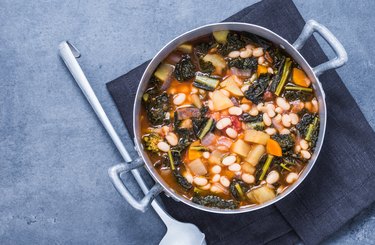
There's nothing more disheartening than slaving over the stove preparing a special soup or stew that called for expensive ingredients and hours of prep time only to be interrupted and have your attention diverted. Minutes or hours away from tending to your pot may turn your piece de resistance into a burnt disaster that is more worthy of the kitchen sink than the dining table. Burnt soup or any other stew-like food is likely to get more "yucks" than "yeses," but if you know a few food prep hacks, that sordid taste can be turned into a gourmet success.
Try the Old Switcheroo
Video of the Day
One of the easiest ways to get rid of the burnt taste in a soup or stew is to simply ladle it out of the old pot and into a new one. Be sure you don't go to the bottom and scrape the burnt bits up and accidentally remove them with the good liquid and vegetables, as this will defeat the purpose. Slowly reheat and taste, adding other ingredients if necessary to fill out what you lost in the transfer.
Video of the Day
If you don't have an additional pot, ladle the contents from the old pot into a bowl. Do not pour. Scrub the burnt bottom thoroughly and then dry it. Put the soup or stew back into the pot and taste it, adding herbs and spices to round out the flavors.
Mr. Potatohead Rescues Burnt Soup
If you are using potato in your soup or stew, know that the potato absorbs flavors from the pot, including the burnt flavor. Remove the infected potatoes, switch pots and add a new, raw potato sliced in quarters to the mix. Let it sit for about 15 minutes. If you need to add potatoes back into your dish, parboil fresh potatoes for 10 minutes and then add them after the raw potato has done its job and has been removed.
Burn-Busting Liquid Ingredients
If there is still a burnt taste after switching the pots, additional ingredients that can come to the rescue include a dash of lemon juice or any vinegar in a small amount. Taste it after every addition to see if it makes a difference. Some sherry or Madeira wine also neutralizes the burnt taste, and both add flavor and substance to your dish.
Other Additions to Use
A teaspoon of sugar or a tablespoon of honey may reduce the burnt taste. Another alternative is a small can of chopped tomatoes or tomato puree if what you are making can use them. A vichyssoise that relies on its creamy look from potatoes and leeks won't work this way, but a hearty vegetable soup or even chili can be rescued by these additions. Just taste it and add sugar if the flavor is sharp.
Some diced onion that has been sautéed or caramelized can also be used to eliminate the burnt taste. Be sure you've transferred the ingredients into a new pot before doctoring your dinner.
Reducing, not Burning
When reducing sauces, soups and stews to concentrate the flavor, pay close attention to the process. Reducing too long often leaves you with a burnt bottom and acrid taste. Depending on what's in your pot, try one of these hacks to bring life back to your preparation. Just remember to switch pots before adding any rescue ingredients.